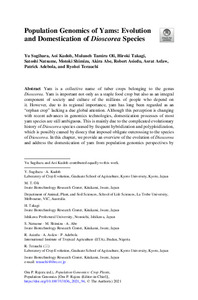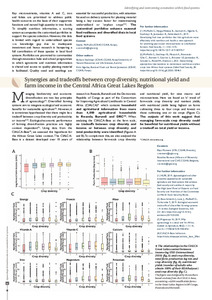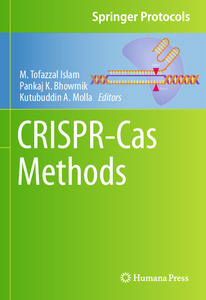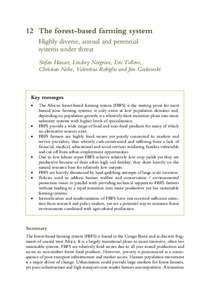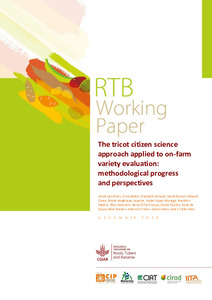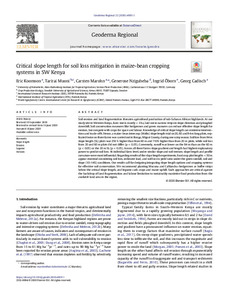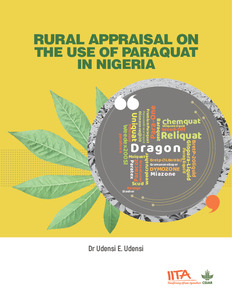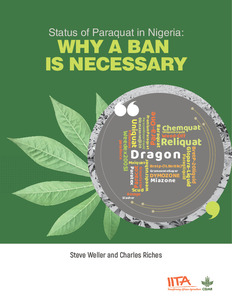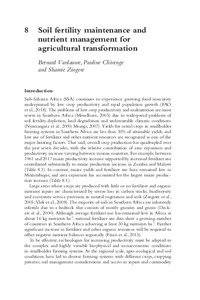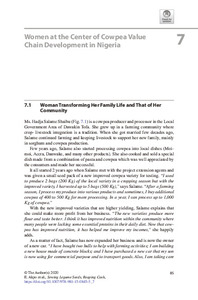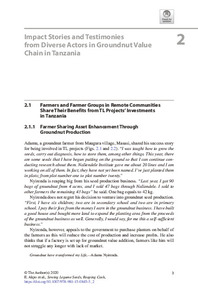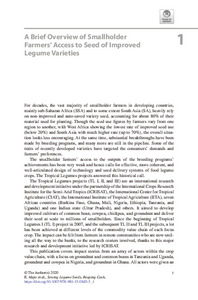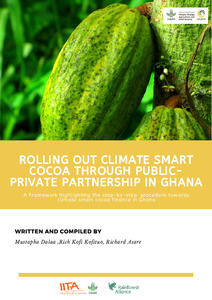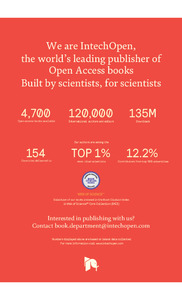Welcome to the International Institute of Tropical Agriculture Research Repository
Books and Book Chapters: Recent submissions
Now showing items 61-80 of 983
-
Next-generation plant health management supported by science-based agroecological principles
(Agropolis International, 2021) -
Population genomics of yams: evolution and domestication of Dioscorea species
(Springer, 2021)Yam is a collective name of tuber crops belonging to the genus Dioscorea. Yam is important not only as a staple food crop but also as an integral component of society and culture of the millions of people who depend on it. However, due to its regional importance, yam has long been regarded as an “orphan crop” lacking a due global attention. Although this perception is changing with recent advances in genomics technologies, domestication processes of most yam species are still ambiguous. This is ... -
Synergies and tradeoffs between crop diversity, nutritional yield and farm income in the central Africa Great Lakes Region
(Agropolis International, 2021-09) -
CRISPR-Cas9-based genome editing of banana
(Springer, 2020)Genome editing is an emerging powerful new breeding tool, which can be applied for genetic improvement of banana for important agronomic traits such as resistance to biotic stresses, adaptation to climate change, and high yielding. Banana is an important staple food and cash crop, feeding millions of people in tropical and subtropical countries. Recently, CRISPR-Cas9-based genome editing system has been established for banana in a few laboratories. Here, we describe the procedures for generation ... -
The forest-based farming system: highly diverse, annual and perennial systems under threat
(Routledge, 2019)African forest-based farming systems (FBFS) are the starting point for most humid zone farming systems; they exist only at low population densities and, depending on population growth, are a relatively short transition phase into more sedentary systems with higher levels of specialization. FBFS provide a wide range of food and non-food products for many of which no alternative sources exist. FBFS farmers are highly food secure yet poorly connected to markets and service providers, thus severely ... -
The tricot citizen science approach applied to on-farm variety evaluation: methodological progress and perspectives
(International Potato Center, 2020-12)Tricot (triadic comparisons of technologies) is a citizen science approach for testing technology options in their use environments, which is being applied to on-farm testing of crop varieties. Over the last years, important progress has been made on the tricot methodology of which an overview is given. Trial dimensions depend on several factors but tricot implies that plot size is as small as possible to include farmers with small plots (yet avoiding excessive interplot competition) while many ... -
Critical slope length for soil loss mitigation in maize-bean cropping systems in SW Kenya
(2020)Soil erosion and land fragmentation threaten agricultural production of sub-Saharan African highlands. At our study site in Western Kenya, farm size is mostly < 2 ha, laid out in narrow strips in slope direction and ploughed downhill. Soil conservation measures like hedgerows and green manures can reduce effective slope length for erosion, but compete with crops for space and labour. Knowledge of critical slope length can minimise interventions and trade–offs. Hence, a maize–bean intercrop (MzBn) ... -
Rural appraisal on the use of Paraquat in Nigeria
(International Institute of Tropical Agriculture, 2020) -
Status of Paraquat in Nigeria: why a ban is necessary
(International Institute of Tropical Agriculture, 2020) -
The root and tuber crop farming system: diversity, complexity and productivity potential
(Routledge, 2020)The root and tuber crop farming system occurs in west and central Africa, bounded on the southern, wetter side by the tree crop farming system and on the northern, drier side by the cereal-root crop mixed farming system. The root and tuber crop farming system occupies an estimated 236 million ha and has an estimated human population of 112 million, of whom over 50 per cent live in rural areas. Poverty is relatively high with about half the rural population earning less than US$1.25 per day. The ... -
Women at the center of cowpea value chain development in Nigeria
(Springer International Publishing, 2020)M s. Hadja Salame Shaibu (Fig. 7.1) is a cowpea producer and processor in the Local Government Area of Dawakin Tofa. She grew up in a farming community where crop- livestock integration is a tradition. When she got married few decades ago, Salame continued farming and keeping livestock to support her new family, mainly in sorghum and cowpea production. -
Impact stories and testimonies from diverse actors in groundnut value chain in Tanzania
(Springer International Publishing, 2020)Adamu, a groundnut farmer from Maugura village, Masasi, shared his success story for being involved in TL projects . “I was taught how to grow the seeds, carry out diagnosis, how to store them, among other things. This year, there are some seeds that I have begun putting on the ground so that I can continue conducting research about them. Naliendele Institute gave me about 20 lines and I am working on all of them. In fact, they have not yet been named. I’ve just planted them in plots; from plot ... -
A brief overview of smallholder farmers' access to seed of improved legume varieties
(Springer International Publishing, 2020)For decades, the vast majority of smallholder farmers in developing countries, mainly sub-Saharan Africa (SSA) and to some extent South Asia (SA), heavily rely on non-improved and auto-saved variety seed, accounting for about 80% of their material used for planting. Though the seed use figures by farmers vary from one region to another, with West Africa showing the lowest rate of improved seed use (below 20%) and South Asia with much higher rate (up to 70%), the overall situation looks less ... -
Breakthroughs in groundnut production communities in Nigeria
(Springer International Publishing, 2020)Mrs. Hadja Talatu Idrissa (Fig. 6.1), a community women leader, is the chairperson of the Bunkure women group that is active in groundnut production and oil processing. The group which counts 25 members joined the TLIII project family 4 years ago. They started growing a small seed pack of 5 kg in their community farmland. “It was the harvest of this seed pack that we revolved and planted in a bigger farm plot in the following year,” reported Mrs. Hadja. -
Rolling out climate smart cocoa through public-private partnership in Ghana: a framework highlighting the step-by-step procedure towards climate smart cocoa finance in Ghana
(International Institute of Tropical Agriculture, 2020)The cocoa industry has been the mainstay of the Ghanaian economy over the years through the provision of revenues from foreign exchange earnings and the generation of employment for farmers who are mainly small holders. Climate change is a phenomenon that has been taking place throughout history but over the last century it has accelerated and scientists believe it is increasingly due to human activities (Cook et al, 2016). The climate in Ghana has likewise been affected and it is having an impact ... -
Stem borers of cereal crops in Africa and their management
(IntechOpen, 2020)The economic importance of the stem borer in Africa results in their severe damage that affect directly cereal yield factors such as the density of fertile tillers and the number of effective panicles. The objective of this paper is to describe and discuss the management options of the main prevalent stem borer of cereal crops in Africa. Host plant resistance, cultural practices, biological control and reasoning chemical control are among the most encouraging options. Integrated pest management ... -
Tools to assess gender inequalities in access to and benefits derived from the cassava seed system
(International Institute of Tropical Agriculture, 2021) -
Understanding differences in climate sensitivity simulations of APSIM and DSSAT crop models
(World Scientific, 2021) -
Mise en oeuvre des plateformes d'innovation: cas du project CDAT
(IInternational Institute of Tropical Agriculture, 2021-11)


